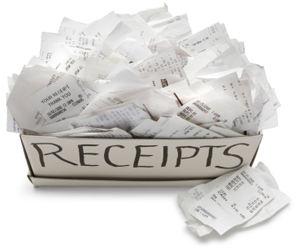If you run a large business or corporation, chances are you have an accounting team to create and manage budgets with a monthly expense worksheet or expense-tracking application.
But what if you’re a small business owner or solopreneur? If your business is small or you’re just getting started, it can be difficult to plan a monthly budget. You may be spending more money than you’re making, and if you’re like most small business owners, you may be pouring a lot of your own financial resources into growing your business.
Even if your budget is different every single month, you can still benefit by using a monthly expense worksheet to track spending, income, write-offs, and payments.
Step 1 – Organize
The first important thing you should do is get organized. Billfolds, filing cabinets and paper clipped stacks of receipts might work for some people, but there is a big chance you could lose an important piece of paper, and nobody has time for that!
One of the best things you can do is scan your receipts, bills and other paper documents so that there is always a digital record of them. An even easier option is using a service that can extract the data for you and export it right into an excel document.
Step 2 – Do the Work
The process of actually making your monthly expense worksheet and doing it well is essential for managing your budget time and time again. So, pull up that spreadsheet and get started!
There are two key categories you’ll need: fixed and variable costs. Once you have these, you can carry the fixed costs over to your expenses worksheet each month and change the variable costs as needed. Remember to cross reference the information in your worksheet with your online checking and banking accounts to verify that everything is correct. Also, check to make sure that the OCR technology from your scanning equipment got everything right. Some scanners only claim accuracy rates of 85%, so ensure that no decimals are transfixed!
Now that you have a spreadsheet template that you can use going forward, you’ll have no problem completing the final step.
Step 3 – Repeat (and don’t get lazy!)
The last step involves simply getting into the habit of managing your monthly expenses. The best way to do this is to add it to your schedule and to hold yourself accountable. Put a date on your calendar each month where you devote a few hours to scanning your receipts. Some people choose to break it up and scan weekly to keep their monthly expense reports in order while others need only do it monthly. Either way, doing this will eliminate the need for a bookkeeper (and as a result, some of those monthly fixed costs!).
Keep in mind that scanning your receipts is a much faster and more reliable solution than paper clipping receipts together and manually entering them into your accounting software. If you’re not using a scanner yet and are considering it, keep an eye out for receipt scanners and scanning services around tax time. Many companies will promote special offers to business owners to get them to buy their products while they’re prepping to file their taxes.
